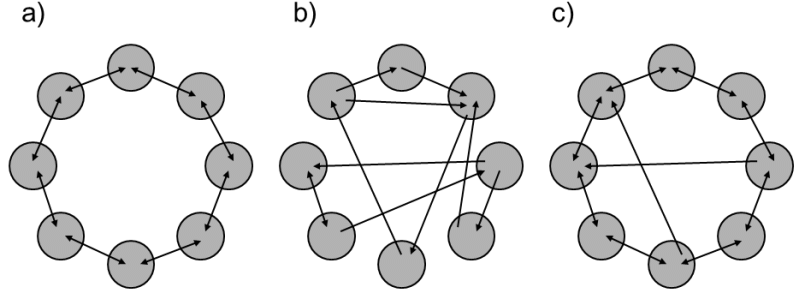VII.1.1 Exchange of migrants between individual populations establishes gene flow.
Metapopulations differ in both the intensity and the nature of migration occurring between their subpopulations. In some metapopulations, the likelihood of migrant exchange between two subpopulations does not depend on their relative distances, while in others migrants are exchanged primarily between neighboring subpopulations (Fig. VII.1). Migration sometimes occurs along a specific

Fig. VII.1 Migration between neighbouring or distant subpopulations. In a viscous population, i.e. a population of individuals with low mobility, migrants are exchanged exclusively or primarily between subpopulations neighbouring in space (a). The opposite situation is one where the probability of migrant exchange between any two subpopulations is approximately identical (b). A very common situation in practice is one where most migrants come from near-by populations, with a non-zero probability of migration also occurring over very long distances (c).
line, such as a coastline, or it can spread in two dimensions, together with the gene flow, covering an area. In the latter case, the rate at which, for example, a mutant allele spreads is substantially lower. Very frequently, one subpopulation produces a large number of migrants covering just a short distance, for example extending only to the neighboring subpopulations and, at the same time, a smaller number of migrants migrating over long distances. Theoretical analyses show that a quite small number of long-distance migrants is sufficient to bring the behaviour of a given system close to that of a system in which elements can interact over any distance. The large effect of a small number of long-distance migrants or a small number of individuals communicating with a large number of other individuals in the system is called the small-world network effect and the processes occurring in these systems are important, for example, in epidemiology (Lloyd & May 2001; Liljeros et al. 2001). Migration between subpopulations tends to be very asymmetrical; some populations produce many migrants, while others produce few but accept large numbers of foreign migrants. As migration often involves exclusively or at least primarily the members of just one sex or gamete (or gametophyte), such as pollen, the intensity of the gene flow on the autosomes, sex chromosomes and in the organelle DNA often varies. The nature of evolutionary processes is different in a metapopulation where the gene flow occurs between more or less permanent subpopulations and a metapopulation where subpopulations constantly disappear and the migrants themselves cause new ones to appear (see VII.8.2) (Shanahan 1998).
